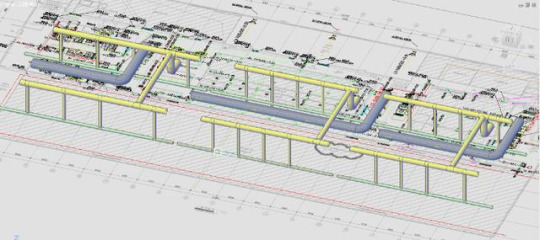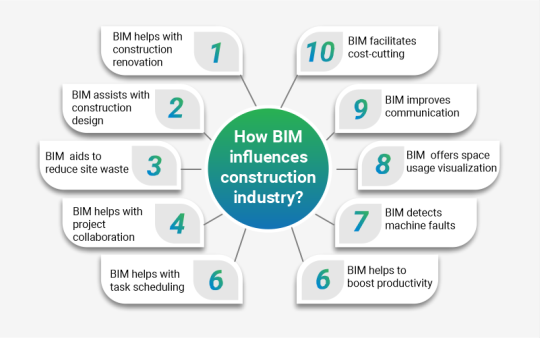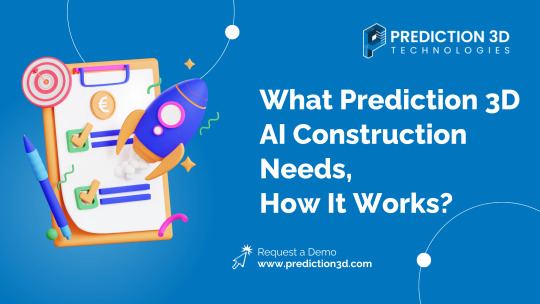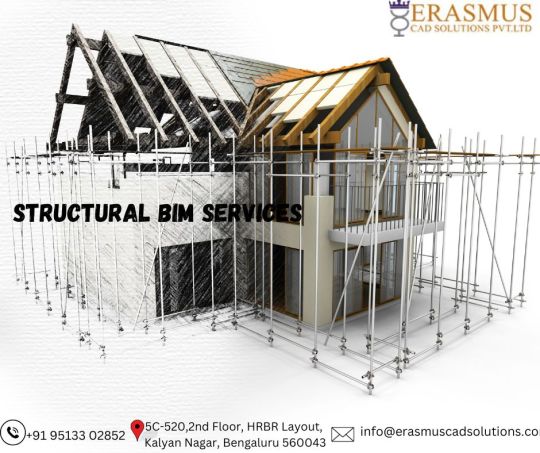#bim technology
Text

Erasmus is one of the topmost Outsourcing architectural 3d visualization and rendering company based out of India, offering graphics rich 3D Rendering Services at affordable prices.
#bim services#civilengineering#bim technology#autocad#2d drafting services#constructioncompany#3d render#rendering#3d bim modeling services#3d cad modeling#data entry#architecture#civil construction#renovation#building#wednesday motivation
2 notes
·
View notes
Text
An Overview of BIM Courses and Placement Assistance
The Architecture, Engineering, and Construction (AEC) industry in India is experiencing a significant transformation, driven by the adoption of Building Information Modeling (BIM). BIM is revolutionizing workflows by creating a collaborative digital environment for managing building projects throughout their lifecycle. This shift presents a tremendous opportunity for professionals seeking to upskill or enter the AEC field.
If you're located in Pune, a hub for AEC activity, and interested in pursuing a BIM course with placement assistance, this guide is for you. We'll explore the benefits of BIM training, delve into the BIM course in Pune, and highlight the importance of choosing a program with placement support.
Why Upskill with BIM Training?
Here are some compelling reasons to consider a BIM course in Pune:
Increased Employability: BIM skills are highly sought-after by construction companies, architectural firms, and engineering consultancies. A BIM certification can significantly enhance your resume and make you a more competitive candidate.
Improved Efficiency and Collaboration: BIM software streamlines project workflows, facilitates communication between project stakeholders, and reduces the risk of errors. Learning BIM will equip you to work effectively in a collaborative environment.
Enhanced Design and Construction Quality: BIM allows for better visualization, clash detection, and cost estimation, leading to improved design quality and reduced construction rework.
Career Growth Potential: With BIM becoming the industry standard, BIM expertise can open doors to exciting career opportunities in project management, design coordination, and BIM implementation.
BIM Course Options in Pune
Pune offers a variety of BIM course providers catering to different learning styles and career goals. Here are some common course formats to consider:
Diploma Courses: These comprehensive programs provide in-depth training on various BIM software like Revit, Navisworks, and AutoCAD. They typically span several months and can be full-time or part-time.
Certificate Courses: These focused programs equip you with specific BIM skills, such as BIM modeling or BIM coordination. They are shorter in duration compared to diploma courses and are ideal for professionals seeking targeted skill development.
Online Courses: Online learning platforms offer flexibility for those with busy schedules. However, online courses may require a higher level of self-discipline compared to classroom-based programs.
Importance of Placement Assistance
When choosing a BIM course in Pune, prioritize programs that offer dedicated placement assistance. Here's why:
Industry Connections: Reputable institutes often have established relationships with AEC companies, providing you with access to exclusive job opportunities.
Career Guidance: Placement teams can help you refine your resume, prepare for job interviews, and develop strong industry networking skills.
Mock Interviews and Portfolio Building: Guidance on mock interviews and portfolio development can significantly enhance your confidence and presentation during the job search process.
Conclusion
Investing in a BIM course with placement assistance in Pune can be a transformative step towards a successful career in the AEC industry. By understanding the benefits of BIM training, exploring available course options, and prioritizing placement support, you can position yourself for exciting opportunities in this dynamic field.
Additional Tips:
Research Course Providers: Carefully evaluate the curriculum, faculty expertise, and industry reputation of BIM training institutes.
Consider Course Project Focus: Choose a course that aligns with your career goals. Some programs specialize in architectural BIM, while others focus on structural or MEP BIM.
Network with Professionals: Attend industry events and connect with BIM professionals to gain insights into the job market and potential career paths.
By following these tips and leveraging the guidance of a qualified BIM institute, you can embark on a rewarding BIM career journey in Pune's thriving AEC sector.
1 note
·
View note
Text
BIM Modular Technology of Durkduct Flexible Air Duct System — Reshape the future of Intelligent Ventilation System
BIM(Building Information Modeling) technology has played a greater role in the construction industry nowadays. With the increasing scale and complexity of construction projects, the traditional GI duct setup is facing new challenges in design, manufacture, and installation. To get these issues solved, BIM Modular Technology and iDuct software have been adapted to the Fabric Fiber Ductwork, achieving the full-process modularization for traditional non-standard air ducting systems from design, manufacture, and installation to after-sale maintenance. It helps to improve the assembly rate of building and speed up the process of electromechanical modularization.

Features and Advantages of BIM Modular Technology for Durkduct Insulated Air Duct System
Modular Design: BIM Technology is adopted with the concept of modular design, separating the Nanosox Insulated Air Ducting System into independent components, parts, and accessories modules, enabling design, construction, and maintenance more flexible and effective. The modularization greatly increases the reusability and standardization, reducing the construction costs in the meantime.
Data Integration: BIM Modular Technology enables the full-process data integration and sharing for multiple Insusox pre-insulated air duct systems, making information delivery more effective in plans, design, manufacture, assembly, and operation. Through the establishment of database, participants are able to share and update data in real time, decreasing the deviation and latency of information delivery, and improving the project’s effectiveness.
Sustainable Development: BIM Modular Technology focuses on sustainable development, greatly decreasing energy consumption and environmental pollution through design and construction optimization. Modular design optimizes the material and energy utilization, reducing carbon emission of air ducts system. The sustainable development concept matches the demands of Green Construction and Emission-reducing.
The Application of BIM Modular Technology in the HVAC/R Industry
Improve the management effectiveness: BIM Technology fulfills the full-process management in various stages, realizing the information seamless connection and work collaboration from air duct design, flexible manufacture, and onsite assembly to maintenance. That greatly increases the effectiveness of project management and reduces the waste of time and costs.
Accelerate the construction process: Different modules of construction can be designed and manufactured in advance through BIM Technology, then assembled onsite, shortening the construction period, and improving effectiveness. Meanwhile, modular design decreases the workload and crew size, reducing construction risk and potential security hazards.
Enhance the system quality: BIM Technology fulfills the standardization and quality control of the air duct system. The prefabrication advances the air duct integrity, minimizing deviations and issues, and improving the entire quality and reliability of the Flexible Air Duct System.
Optimize the space utilization: The BIM Technology empowers the precise layout of the construction site. The air ducting system could be assembled flexibly according to the actual situation, making the best use of space. It’s especially significant for the construction site where the height is restricted, the utilization and value of the space are highly enhanced.

BIM Modular Technology of Durkee Textile Ventilation System features modular design, data integration, and sustainable development, bringing fresh solutions to the construction industry. The technology can not only improve project management effectiveness, optimize space utilization, and accelerate the construction process, but also advance the building quality greatly. In the near future, BIM Modular Technology will undoubtedly play a more significant role in the construction industry, boosting the development of intelligent construction, and delivering a comfortable environment for the future.
#fabric air duct#hvac duct manufacturers#ventilation#air duct#nanosox#insusox#buildings#bim technology
0 notes
Text

La nostra piattaforma è una soluzione di gestione centralizzata dei dati per edifici e infrastrutture. La piattaforma UTwin è basata sul digital twin, che memorizza e traccia tutti i dati degli asset in un'unica interfaccia e fornisce una soluzione ottimale per la gestione a 360° degli edifici durante il loro intero ciclo di vita.
1 note
·
View note
Text
The construction industry is a significant contributor to global energy consumption. Building Information Modeling (BIM) offers a powerful platform to integrate design, construction, and operational data, enabling a data-driven approach to building energy optimization.
This service leverages BIM to create Building Energy Models (BEMs) that simulate a building's energy performance throughout its lifecycle. By analyzing various design options and operational strategies, this service helps achieve significant energy savings, leading to reduced costs, improved occupant comfort, and a minimized environmental footprint.
Building Information Modeling (BIM) for Building Energy Modeling (BEM)
BIM goes beyond traditional 3D modeling by incorporating rich data about building components, materials, and systems. This data-rich environment is crucial for creating accurate BEMs. BIM software allows users to define physical properties of building elements like walls, windows, and roofs.
These elements are then linked to their corresponding energy properties like thermal resistance and solar heat gain coefficient. Furthermore, BIM facilitates the integration of building systems like HVAC (Heating, Ventilation, and Air Conditioning) and lighting. This comprehensive data set within the BIM model empowers the creation of a reliable BEM.
Read more
0 notes
Text

The primary benefits of BIM in architecture, engineering, and construction industry include:
Facilitates cost-cutting
Onsite communication facilitator
BIM offers preconstruction project visualization
Clash Detection
BIM increases the productivity
Offers better safety on construction sites
0 notes
Text
0 notes
Text
What Prediction 3D AI Construction Needs, How It Works?

In the construction industry's quest for efficiency and innovation, Prediction 3D AI emerges as a transformative solution, addressing critical needs and reshaping the construction landscape. Understanding how this technology works is essential for construction professionals looking to enhance project management and streamline processes.
I. Addressing Construction Needs
A. Predictive Decision-making
Prediction 3D AI addresses the need for predictive decision-making in construction. By analyzing historical data and patterns, it empowers project managers to make informed choices, anticipate challenges, and proactively plan for successful project outcomes.
B. Efficient Resource Allocation
One of the crucial needs in construction is the efficient allocation of resources. Prediction 3D AI seamlessly integrates predictive analytics and 3D modeling, providing a comprehensive view of the construction process. This ensures optimal resource allocation, minimizing waste and maximizing efficiency.
II. Mechanics of Prediction 3D AI
A. Predictive Analytics
Prediction 3D AI begins with predictive analytics, utilizing algorithms to analyze data and identify patterns. This phase allows the software to foresee potential challenges, enabling construction professionals to strategize and plan effectively.
B. Integration of 3D Modeling
The integration of 3D modeling is a AI automated scheduling pivotal aspect of Prediction 3D AI. This step brings a visual dimension to the data, allowing stakeholders to understand project intricacies in a detailed and accessible manner. Visualization enhances decision-making and facilitates precise resource allocation.
C. Real-time Adaptability
Prediction 3D AI thrives on real-time adaptability. As construction projects unfold, the software dynamically adjusts automated schedules and resource allocations to respond to changing conditions, ensuring optimal project efficiency even during peak workloads.
III. Transformative Impact on Construction Processes
Prediction 3D AI transforms construction processes by providing a proactive approach to decision-making and resource management. This technology doesn't just meet needs; it anticipates them, offering a solution that aligns seamlessly with the dynamic nature of construction projects.
IV. Embracing the Future of Construction
In conclusion, "Prediction 3D AI Construction Needs, How It Works" underscores the symbiotic relationship between the needs of the construction industry and the capabilities of advanced technology. Embracing Prediction 3D AI is not just an integration of automated construction scheduling software; it's an embrace of the future of construction, where needs are met with foresight, decisions are made with precision, and projects unfold with unprecedented efficiency.
#construction software#software engineering#artificial intelligence#estimating software#construction#ai on construction#automated scheduling in construction#bim consulting services#bim modeling services#bim technology#bim services
1 note
·
View note
Text
Civil Engineering makes use of several software packages. A multitude of software applications is being developed to serve civil engineering needs due to the Technological Revolution. Therefore, listing out all of these would be a complicated task. There are multiple sub-disciplines to Transportation Engineering like Structural Engineering, Surveying, Geotechnical Engineering, Environmental Engineering, and Construction Planning. Civil engineers worldwide use these applications frequently.
BIM (Building Information Modeling)
One of the most important innovations in the 21st century has been Building Information Modeling. BIM (Building Information Modeling) is an effective tool for architects, engineers, and construction professionals (AEC). It enhances building planning, design, construction, construction management, and maintenance.
Building Information Modeling (BIM) software, Revit, is specifically designed to help construction professionals create coordinated, model-based approaches to bring ideas to construction. It combines the functionality of all three Revit disciplines (architecture, mechanical, and electrical) in one streamlined interface.
AutoCAD
The AUTOCAD program by Autodesk allows the construction projects to draft and documented. Many structural design firms and consultancies use this software, especially in India. Modeling in 3D is also possible using AUTOCAD 3D.
Design & analysis have been disrupted by AUTODESK, a leader in software innovation. Architects, engineers, manufacturers, and designers can benefit from its software for Computer-aided design, modeling, drafting, and engineering software.
MS Excel
Spreadsheet software from Microsoft is called Excel. With Visual Basic for Applications, users can create macro programming languages, calculations, graphs, and pivot tables. This spreadsheet is widely used on these platforms. Surveying, Analysis, and Design are used widely in Civil Engineering.
STAAD PRO
Many professionals in the construction industry choose Bentley System's STAAD PRO for designing and analyzing structures.
Read more
#civil engineering#construction#concrete#AutoCAD#BIM#bim technology#Civil Engineering#Environmental Engineering#Construction Planning
0 notes
Link
Building Information Modeling (BIM) technology is the most promising development in the AEC industry. With BIM Modeling, an accurate model of the building is developed which is intelligent and interoperable.
It helps architects, engineers, and contractors to visualize what is to be built in a simulated environment to identify any potential design errors.
Nearly half of contractors (45%) use BIM on less than 15% of projects, and barely a quarter (23%) used it on more than 60% of projects, while architects were the largest users (43% used it on more than 60% of their projects). Eighty-two percent of BIM users reported a significant increase in productivity due to using BIM. The use of BIM in construction will significantly increase in the near future because of the amazing advantages of BIM technology for the AEC industry.
For more information, read our complete article.
0 notes
Text
What are the key benefits of BIM services for building owners?
Building Information Modeling, one of the most revolutionary disciplines in building design and engineering, is a widely accepted technique in the construction industry. By enabling architects and engineers to more accurately assess performance, BIM services are driving significant transformation in these areas. They can also quickly study the effects of different design scenarios and evaluate the functional qualities of different materials and systems. Owners, in addition to designers and engineers, gain a lot from BIM. Here are some of the key benefits of BIM for owners.

Improved building design: Developing drawings and making revisions takes time and money. However, BIM facilitates changes more efficiently and reduces omissions when incorporating the entire project documentation.
Integrated Workflow: BIM services enable design, engineering and system coordination as well as optimization of the information management process.
Cost estimation accuracy: BIM allows us to evaluate systems and project operating costs more accurately. They also enable accurate designs and reduce the number of change orders.
Simplified and efficient maintenance: One of the key benefits of BIM services is simplified maintenance. Engineers can easily use maintenance systems. Thanks to the ROI of BIM. Tools and equipment in this model are used by workers to maintain inventory, goods, and property. Effective maintenance is also enabled by BIM, which offers scenarios and schedules that ensure the building can be scaled up or down while maintaining peak performance and evaluating new systems in the future.
Enhanced branding: BIM services ensure that users are held to corporate standards and that timely conception and enhanced visualization of the entire concept is ensured.
Sustainable building performance: BIM allows engineers to evaluate a building's carbon footprint and consider the impact of new, environmentally friendly technology compared to the facility's resource requirements, including the effects of sun, weather and wind. They also have access to real materials, supplier products, energy and lighting systems for optimized performance and comfort.
Efficient use of available energy: BIM ROI can be used to more accurately use all forms of energy, including human and mechanical work. Hence, it is not necessary to assign different engineers to different construction or construction activities. Simply focusing on the benefits of BIM will enable the owner to utilize the available energy.
Improved Lifecycle Management: Improved lifecycle management is one of the best-known benefits of Building Information Modeling. BIM services can be used to give owners better options for life cycle management. Modern technologies such as BIM are essential to reduce costs as construction supplies and labor become more and more expensive every day.
BIM technology is successful in providing more financial benefits to owners. Choose BIM services such as CAD to BIM conversion, shop drawing services, quantity takeover, 3D laser scanning and facility management from Tejjy BIM Inc USA and maximize the ROI of your construction project as a building owner.
#architecture#building#architexture#city#buildings#skyscraper#design#cities#town#urban#bimconsultant#bim technology#bim services#3d laser scanning services#maryland#florida#usa#chicago#tejjy#tejjy bim inc#business
1 note
·
View note
Text

Erasmus is one of the leading Outsourcing Partner and one-stop solution provider for BIM MEP services based out of India.
#constructioncompany#civil construction#bim technology#bim services#cad#autocad#mep design#mep engineering#data entry#data mining#happy tuesday
2 notes
·
View notes
Text
Are you looking for accurate and streamlined planning? Want full project visualization? Choose BIM technology from Top BIM Company and get easy and real-time access to building information. To know more about BIM services, get in touch with Top BIM Company at 240 899 7711 or [email protected].
0 notes
Text
5 Ways Prefabrication Benefits your Construction Project
In the last few years, Global demand for infrastructure and real estate ventures has grown. According to a leading report, about 13% of India’s GDP will be contributed by the construction industry by 2025. So, imagine the contribution of the construction industry towards the GDP of various developed countries!
In addition to that, the rise of cutting-edge technologies like Artificial Intelligence/Machine Learning, Building Information Modeling (BIM), Virtual Reality and Artificial Reality will certainly help bring about a radical change in the construction industry.
For a long time, the construction industry was the least advanced, in terms of digitization and utilization of technologies, but this is about to change dramatically in the next few years.
Ai has already created the groundwork for the construction industry’s digitization with BIM technology. It’s mind-boggling to consider the exponential growth of this industry and it is our goal to keep up with the current demands and trends of the construction industry while maintaining high-quality production and minimizing safety challenges.
“Prefabrication is a growing trend that has the potential to overcome these challenges.”

What is Prefabrication?
Assembling the components of a building or a structure in advance at a manufacturing site/factory, and then bringing them to the construction site, is known as prefabrication
Prior to the start of a project, a third-party provider constructs and puts together a number of components that will be used for the construction project.
Did you know? This practice is not new. Prefabrication techniques date back more than a century ago!
But, during those times, prefabrication was associated with off-site, modular buildings of interior quality, which is why it failed to catch on.
However, BIM technology has revolutionized this approach in the past few years. As the quality and efficiency of prefabrication improve, it is becoming more common. But, why is BIM proving to be a catalyst for prefabrication?
By generating 3D models, BIM makes projects easier to visualize. Accurate data about building materials and the design of the construction project (thanks to BIM) helps improve coordination of production. In addition to that, BIM usage is helping to close the productivity gap in prefabrication. By the year 2023, modular construction is expected to grow by 6%.
5 Ways Prefabrication can help your Construction Project
Shorter Construction Duration
This sort of modular construction project is considerably faster than traditional construction.
According to a major study, a modular building can be erected up to 50 percent faster than conventional construction, allowing a project to go from inception to completion swiftly and without difficulty, achieving a rapid return on investment.
This is a result of improved up-front planning, avoidance of on-site climatic variables, subcontractor planning and scheduling delays, and the concurrent construction of many sections.
Rather than focusing all of their attention and resources on one or a few projects, construction firms are able to take on numerous projects at once which allows their business to grow and expand.
Read More About it
#Construction Project#BIM#bim technology#What is Prefabrication#real estate#building information modeling#Prefabrication Benefits#Sustainable Construction
0 notes
Text
In the dynamic realm of construction, precision and efficiency are paramount. Scan to BIM technology emerges as a transformative force, reshaping the way we approach building projects.
Harnessing the Potential: Understanding Scan to BIM
The Essence of Scan to BIM
Revolutionizing the traditional workflows, Scan to BIM integrates laser scanning technology with Building Information Modeling (BIM). This fusion allows for the creation of accurate 3D models, providing a comprehensive view of the existing structures or environments.
Breaking Down the Workflow
Laser Precision Scanning: The process begins with high-precision laser scanning, capturing every detail of the physical space.
Data Conversion to BIM: The scanned data is meticulously converted into a BIM model, ensuring a digital replica mirrors reality.
Enhanced Collaboration: Stakeholders collaborate seamlessly, utilizing the 3D model as a centralized reference for design, analysis, and decision-making.
The Advantages of Embracing Scan to BIM
1. Accuracy Redefined
Say goodbye to the margin of error. Scan to BIM delivers unparalleled accuracy, minimizing discrepancies and facilitating precise planning and execution.
Read more
0 notes
